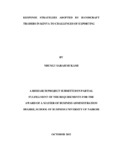| dc.description.abstract | Numerous studies carried out on strategy have concentrated on response strategies of different organizations with none on the handicraft sector. Handicraft business has increasingly become an important employer for majority of rural population and the youth. Majority of these players lack appropriate knowledge on export business thus facing major challenges. Unlike horticulture export, handicrafts are a small scale undertaking and lacks structured export bodies which can assist in export. Review of past studies reveals that nothing much has been covered on the handicraft sector compared to other export commodities from the Kenyan economy. This study employed a descriptive research design. The target population consisted of 177 traders who are actively involved in export of handicrafts. The sample size of the study was 85 export traders. Simple random sampling method was used to obtain the sample size. Data collection was done using a questionnaire while data analysis was done using descriptive statistics.
From the findings, the study concluded that the majority of the handicraft businesses were based on individual ownership with limited financial capital base to expand and take advantage of the existing opportunities in the global market. In addition the main destinations of Kenyan handicrafts are Europeans countries and USA respectively. There is wide range of handicraft products from the Kenyan exporters which enhances their competitiveness in the global market. The majority of handicraft traders export their products indirectly through agents and majority of them never promote their products abroad. This has been attributed to lack of adequate marketing skills and financial resources to fund marketing efforts. The most significant challenges facing export of handicrafts by Kenyan traders were high packaging and shipping costs, high and ever changing tariffs, certification and quality standards set by importer countries, counterfeits and lack of patent laws and lack of innovation and creativity amongst artisans to meet market specifications and demanding contracts respectively. The action plans to overcome export related challenges of handicrafts in Kenya included „participation in training programs and workshops to enhance skills, use of credit
vi
facilities and loans to support business and differentiating of products to offer unique and high quality products respectively. The study recommends that the government and other key players in the handicraft sector should coordinate to address the challenges facing Kenyan handicraft traders in exporting their products. The study also recommends that government and other stakeholders should explore ways of enhancing accessibility of credit facilities to the handicraft traders to enable them expand their enterprises and reduce the middlemen in order to maximize on their profitability. The study further recommends that government and other stakeholders should organize regular marketing forums and scale up the existing ones for the Kenyan handicraft traders in the various export destinations to promote the handicraft sector. The study also recommends that Kenyan handicraft traders should adopt the modern technologies of production and marketing of their products to gain a competitive edge in the export business. | en |

